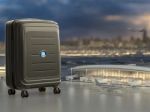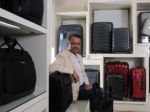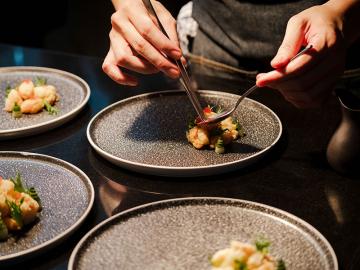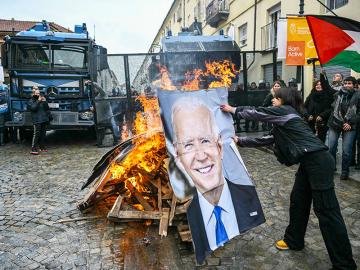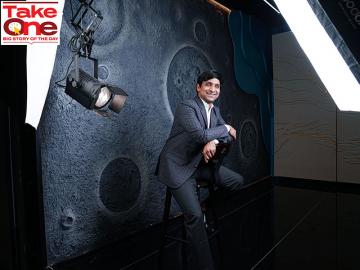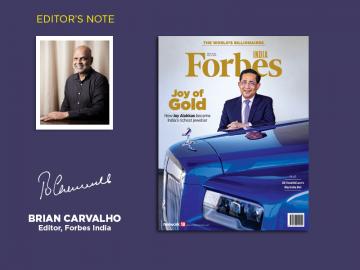
How Mokobara shed its baggage
A mechanical engineer from Raipur and a designer from Renukoot are trying to disrupt the staid travel and luggage industry with their bold and flamboyant design play. Can Mokobara change the rules of the game with its radical fashion statement?
 Sangeet Agrawal (left) and Navin Parwal, Cofounders, Mokobara Image: Selvaprakash Lakshmanan for Forbes India
Sangeet Agrawal (left) and Navin Parwal, Cofounders, Mokobara Image: Selvaprakash Lakshmanan for Forbes India
May 2019, Bengaluru. The cafeteria was crammed with young coffeeholics. Sangeet Agrawal and Navin Parwal, too, placed an order for a steaming cuppa, dashed to occupy the lone vacant table parked in the heart of the restaurant, and elegantly displayed their ‘dazzling baby’ on the wooden surface. Brimming with excitement, the friends anticipated a wild ‘shock and wow’ from the crowd who they thought would be bewitched by the beauty of the object flaunted on the table. “We expected magic,” recounts Agrawal.
Meanwhile, inside the café in Bengaluru, there was more shock and awe. “Nobody came to us and asked where we bought this luggage from,” laments Parwal, who was a reluctant partner in the crime of starting a travel product brand. “I don’t want to sell bags in my youth…I am quite happy with my job,” was how he snubbed the initial overtures of his former Urban Ladder colleague Agrawal, who wanted to rope in the ace designer for his maiden entrepreneurial venture. “It is very boring and something that doesn’t excite me,” Parwal stayed adamant for a while but agreed to explore the idea.

The duo decided to start with cabin luggage. Hours of brainstorming in the evenings and late nights, months of relentless pursuit of what it takes to build a disruptive product, and pumping in loads of hard-earned risk capital resulted in the prototype. “We wanted to create magic over mundane,” says Agrawal. Undeterred by the muffled reaction, the friends tried to find out why their magical product looked mundane. The reasons were many.
Agarwal explains. “It was not 100 percent right,” he says, adding that the bag had the best wheels, but the choice of molding was erroneous. While from a quality point of view, stability, wheel alignment, and wheel movement were something that needed to be fixed, in terms of style and design, the product still lacked the desired swag. For the next four months, Agrawal and Parwal worked on multiple prototypes, and finally, towards the fag end of 2019, the duo was ready with their final prototype.

The stage was set for the launch in December, and the bags just needed to be shipped. But call it either the brashness of the young guns or the audacity of the rookie founders, the duo decided to perform a ritual ahead of the official rollout. “We took the final prototype and went to meet one of the dinosaurs of the travel and luggage industry,” says Agrawal. The ‘dinosaur’ he was alluding to was one of the top players who had been in the ring for decades. “The idea was to see their reaction,” adds Agrawal, who expected bouquets.
What was lavishly showered, though, was brickbats. “Are you guys nuts? Have you made an object of beauty or a bag,” exclaimed the founder. “And look at the price tag. Who will buy such a costly product,” he freaked out, underlining the point that the pricing was prohibitive, and the product won’t have ample takers. “At max, you guys will end up doing Rs 15 crore in your lifetime,” he taunted.

The friends smiled, barged out of the room, and congratulated each other. They knew Mokobara had passed the litmus test. “The way they (rivals) think versus the way we think is where our big opportunity lay,” says Agrawal. “We were doing the opposite of what these guys had been doing for ages,” adds Parwal. The incumbents were carrying the baggage, and the new kids on the block were flaunting their new bags. “And that’s the reason we were sure of our success,” he says.
Also read: VIP Industries' business woes could delay promoters' stake sale plan by a year
In January 2020, Mokobara went direct to the consumer, and started selling online with six colour variants. In the first month, it shipped 200 units. The next month, it sold twenty more units and by the third week of March, it was on track to clock 300 units. In fact, in March, Mokobara had raised its seed round of funding, and was all set to ramp up production. But then came the pandemic, and travel disappeared. “Nothing could be worse than this, right?” reckons Agrawal. “We quit our jobs, started this travel fashion and lifestyle brand, and after three months, travel looked like an alien thing. A prolonged spell of lockdown pushed the founders to the edge and they thought that they might have to pack the bags. “The problem was not the runway. We had seed money. But there were no travellers. Nobody was buying luggage,” quips Parwal.
With their back against the wall, the founders explored jarring options to remain afloat. From making vegetable and fruit washers to hand sanitisers to even the idea of manufacturing slippers, Agrawal and Parwal scouted for all mundane survival options. There was one problem, though. The founders could never convince themselves to start any new project. Reason? The greenhorns were still hooked to magic. “No matter what we explored, we kept coming back to Mokobara,” says Agrawal. His partner shares his evangelical belief. “We were convinced that magic would happen after the waning of the pandemic,” says Parwal, adding that all that the co-founders needed to do was to stay patient and tide over the storm.

Patience, meanwhile, grew thin over the next one-and-a-half years. While intermittent lockdowns would crash the sales of bags, opening of travel would see a spurt in numbers. For somebody who never counted patience as a virtue—Agrawal quit M&M because he was too restless to see the results. And why not? Automobiles take months if not years. The pandemic taught a priceless lesson. “For two years, we kept reminding ourselves why we needed to be patient,” says Agrawal.
Cut to April 2024. The co-founders are busy reaping the sweet fruit of patience. Look at the numbers. From a paltry Rs 12.18 crore in operating revenue in FY22, the numbers have leapfrogged over eight times to Rs 100 in FY24. “These are conservative numbers and unaudited,” says Agrawal, who claims that the startup turned Ebitda positive in FY24. There is, though, another slice of data that carries more heft than the bottom line. Look at the monthly units sold. From 200 units a month, sales jumped to 1,000 units in 2021, and soon to 5,000 per month. It then doubled to 10,000 and is now shipping over a staggering 35,000 units every month. “We are now clocking a revenue run rate of close to Rs 200 crore,” he claims. “And we are just getting started.”

The backers are delighted with the performance. “Investing in Mokobara was a quick decision for me,” says Manu Chandra, founder and managing partner of Sauce VC. The opportunity, he adds, seemed obvious and the co-founders displayed loads of passion to build something exciting in a jaded luggage market. “Everything was refreshing and youthful, and was perfect for the new-age consumer,” he adds.
What also helped Mokobara was a jaded luggage and accessory market. There were legacy companies, but all had products. There was no emotional connect or possessiveness about the product. “The market was full of bags, but what was missing was brand,” says Mokobara’s Agrawal who shares an interesting learning from his professional stint. Urban Ladder and M&M, he reckons, were the places that made him realise what he wanted to do in his life. “Flipkart was a place where I figured out what I didn't want to do in life,” he says, adding that he wanted to build products and not run a retail business.
Agrawal’s conviction resonated with his former employer. Ashish Goel, founder of Urban Ladder and one of the prominent angels backing Mokobara, reckons that the co-founders made the most of a market that was ripe for disruption. “Mokobara started as a crazy vision that Sangeet shared in a conversation about how he imagined a travel product,” he recounts. Having worked with Sangeet and Navin in Urban Ladder, Goel was convinced that the mavericks could create something big if they joined hands. “Sangeet’s sharp product thinking stands out, and Navin’s brand thinking is exceptional,” he says.

Though Moko has made a big-bang entry, it has to deal with a fair share of challenges. The biggest being copycats. “Look at the market now. Every brand now looks like Mokobara,” contends Ashita Aggarwal, professor (marketing) at SP Jain Institute of Management and Research. What’s happening with Mokobara is similar to the narrative that has played out in the smart fan segment in India. Atomberg, she underlines, was the first one to roll out energy-saving BLDC fans, and later on everybody loaded their products with the same technology. “Mokobara has to stay two steps ahead of the look-alikes, me-too and copycats,” she says. What this means is an unrelenting focus on innovations.
The second issue for the challenger brand would be expanding its retail footprint. Though it started as a direct-to-consumer online brand, Mokobara needs to aggressively scale its offline presence if it needs to scale up its operations. “It’s a consumer brand in a country where touch and feel still matters a lot. So, Mokobara must be visible across the country,” she adds.

The co-founders, for their part, are aware of the challenges. “The next three big things for us are retail expansion, beefing up our product portfolio and overseas play,” says Agrawal, adding that the brand is making a strategy to open 100 stores over the next few years. The second big theme, he adds, is an expansion of a product portfolio. Mokobara started with cabin luggage and then ventured into backpacks and accessories. “Now we are toying with handbags and kids as a category,” he says. The brand, he lets on, is actively looking at Southeast Asia, UAE, and Singapore for its overseas’ play.
The big question, though, for Mokobara is: Can it continue with its dream run? The co-founders are confident of a bright future. “We are fearless, we don’t carry any baggage, and we will keep conjuring magic over mundane,” says Agrawal. His partner has another reason for betting on a promising future. “We never called ourselves a luggage company. We are a travel fashion and lifestyle brand,” he signs off.
Post Your Comment

